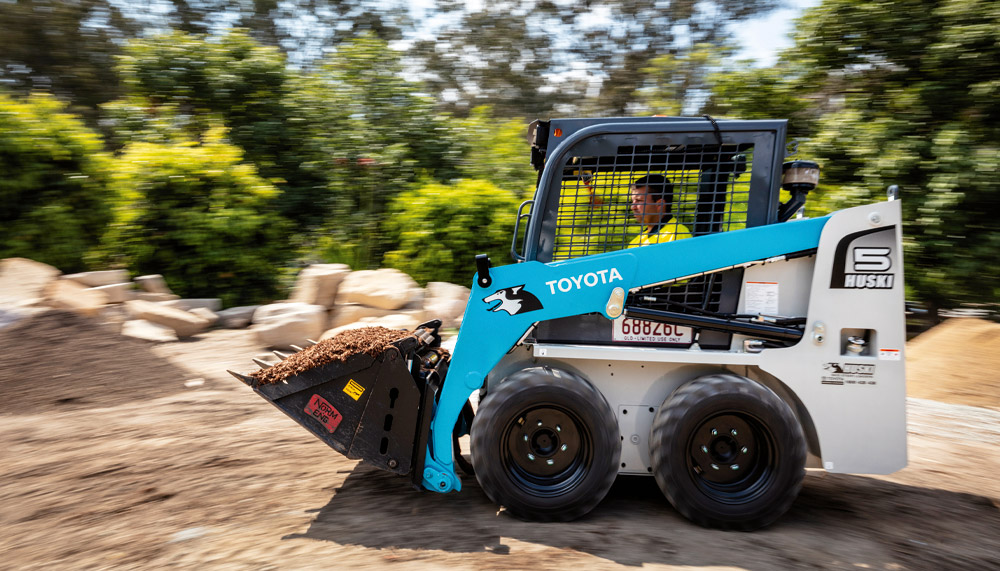Toyota’s skid steers are versatile and valuable tools.
Story Bruce McMahon
Skid steer loaders are valued work machines from building sites to cattle stations across Australia. There are a number of makes and models on the market available with a range of attachments, from four-in-one buckets to fence post rammers. Included in that mob are six different versions of the Toyota Huski, ranging in price from $33,000 to $60,000.
On paper, a skid steer is easy work. Hand controls to each side of the operator govern forward progress and speed, plus steering. Push left-hand control to the right and the Huski pivots right in the direction the tyres are pushing it, while the stationary side skids; push the right-hand control left to skid left. You can just about turn a 3.2m long machine on a 20-cent coin.
On the Toyota, a left-hand foot pedal controls lifting and lowering of the boom with heel-and-toe movement. The right-hand pedal tilts the bucket or attachment, plus opens and closes a four-in-one bucket where fitted.
Basic operations are logical, yet it can take hours of working a skid steer to be competent – it needs a fair degree of hand-feet-brain coordination.
Climb up and swivel your backside into a Toyota Huski 5SDK9 and you’ll find a reasonable amount of room. Slide the seat safety bar down over the head, fire up the 66-horsepower diesel and adjust the throttle lever from tortoise to rabbit.
Above and to the left is a handbrake switch, plus one to allow the loader to operate. Push both hand controls forward and move off as smoothly as possible: a skid steer, with no suspension and short wheelbase, can become a jittery piece of machinery if out of rhythm.
Normal tyre pressure of 60psi can be dropped if needed for better traction, and perhaps more comfort, while filling back wheels with water can help counter heavy loads up front. The rear-engined Huski’s unladen weight is 40–60 to the rear.
Now head toward that pile of cow manure that needs shifting from there to here. Aim the bucket – it may need practice to find the leading edge – push forward, scoop up the material and lift. Back up with care – rear vision is restricted – while remembering that closing and opening this bucket is controlled by that right-hand lever moved sideways. It is easy to find the lever’s been nudged the wrong way, releasing a load wide of the mark.
With bucket open, this is a handy scraper or grader for earthmoving (or cleaning out dairy yard muck), whether using the exposed blade on the front or the rear end of the bucket.While the bucket here is only 1.5m wide with 730kg lifting capacity, the compact size of a skid steer and manoeuvrability allows for higher work speed over bigger tractors when shifting soil or silage in confined spaces. There is also scope for more precise and tidier finishes.
Toyota Material Handling’s Brisbane-based Mick Brumm regards himself as handy with a skid steer rather than an expert. While cleaning out a drainage channel to showcase the 5SDK9’s capabilities, he picks up two pieces of a broken concrete slab then neatly replaces them and, with a nudge from the bucket, has the pieces of the metre-square slab rejoined with just a hairline crack showing.
Toyota Huskis are sold to folk from builders to farmers and fencing contractors. With the right attachments, a skid steer can pull up fence posts, clean up the fence line, bore post holes and then ram posts. Versatility is the key.
As with most skid steers, the Huski relies on hydraulics for all its work – whether driving or lifting. So there is 60-odd litres of fluid running through hoses at around 207 bar or 3000psi of pressure. Toyota recommends using engine oil, handy for simplifying a farmer’s stock of lubricants.
Mick says the Toyota name helps sell the Huski, as does parts commonality with other Toyotas. For example, the cap to the 85L fuel tank is the same used on LandCruisers, and fuel and oil filters are also common with Toyota vehicles.
The engine compartment is cramped, although the radiator swings out for better access for those 250-hour oil and filter changes or 500-hour hydraulic oil changes. Toyota offers a three-year, 3000-hour warranty but Mick has seen a Huski with 8000 hours on the meter and, aside from fresh pins and bushes, nothing replaced on engine or hydraulics.
The Toyota brand, known for reliability, plus the adaptability of skid steers, make the Huski a valuable workmate for any number of operators and jobs across the countryside.
This story excerpt is from Issue #133
Outback Magazine: Oct/Nov 2020










